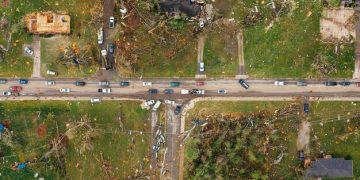Public-Private Partnerships in US Humanitarian Aid: Challenges & Opportunities

Public-private partnerships (PPPs) in US humanitarian aid present both significant challenges, such as differing objectives and bureaucratic hurdles, and crucial opportunities, including resource mobilization and enhanced efficiency in disaster response and recovery efforts.
In the realm of US humanitarian aid, **public-private partnerships (PPPs)** are increasingly recognized as vital instruments. These collaborations, however, are not without their complexities, presenting challenges alongside significant opportunities to enhance the effectiveness and reach of aid efforts during crises.
Understanding Public-Private Partnerships in Humanitarian Aid
Public-private partnerships (PPPs) have become increasingly prevalent in the humanitarian sector, particularly within the United States. These collaborations aim to leverage the strengths of both the public and private sectors to improve the efficiency, effectiveness, and reach of humanitarian aid efforts.
PPPs involve a wide range of collaborations, from simple funding agreements to complex operational partnerships. They can be implemented at various stages of humanitarian assistance, including disaster preparedness, emergency response, recovery, and long-term development.

Benefits of Public-Private Partnerships
One of the key advantages of PPPs is the ability to mobilize resources and expertise from diverse sectors. Private companies often possess specialized skills, innovative technologies, and logistical capabilities that can significantly enhance humanitarian operations.
- Resource Mobilization: PPPs can unlock financial resources, in-kind donations, and logistical support from the private sector.
- Expertise and Innovation: Private companies bring specialized knowledge, technologies, and best practices to humanitarian efforts.
- Efficiency and Scalability: Leveraging private sector efficiencies can lead to faster and more scalable responses to crises.
Furthermore, PPPs can foster greater accountability and transparency in humanitarian aid. By involving multiple stakeholders, these partnerships promote collaborative decision-making, shared responsibility, and rigorous monitoring and evaluation.
In conclusion, public-private partnerships in humanitarian aid represent a promising approach to addressing complex challenges and maximizing the impact of aid efforts. However, successful implementation requires careful planning, effective communication, and a clear understanding of the challenges and opportunities involved.
Identifying the Key Challenges in PPPs
While the potential benefits of public-private partnerships in humanitarian aid are significant, several challenges can hinder their effectiveness. Addressing these challenges is crucial for ensuring that PPPs achieve their intended goals and deliver meaningful impact.
One of the primary challenges is aligning the often divergent objectives and priorities of the public and private sectors. Government agencies typically prioritize public welfare and equitable distribution of aid, while private companies are often driven by profit motives and business interests.
Conflicting Objectives and Priorities
Bridging the gap between these differing objectives requires a clear understanding of each partner’s motivations and a commitment to finding common ground. Transparent communication, shared decision-making, and well-defined partnership agreements are essential for mitigating potential conflicts.

Bureaucratic Hurdles and Regulatory Constraints
Another significant challenge is navigating the bureaucratic complexities and regulatory constraints that often accompany government involvement. Lengthy approval processes, cumbersome procurement procedures, and conflicting regulations can delay implementation and increase transaction costs.
In summary, overcoming the challenges in public-private partnerships requires a proactive approach, fostering open communication, building trust, and establishing clear guidelines. By addressing these issues, PPPs can unlock their full potential and deliver more effective and sustainable humanitarian aid.
Exploring Opportunities for Innovation and Efficiency
Amidst the challenges, public-private partnerships in US humanitarian aid also present significant opportunities for innovation and efficiency. By leveraging the strengths and resources of both sectors, PPPs can drive advancements in disaster response, resource allocation, and long-term recovery efforts.
One key opportunity lies in the adoption of innovative technologies and data-driven approaches. Private companies often possess cutting-edge technologies, such as advanced mapping tools, real-time monitoring systems, and predictive analytics, that can enhance situational awareness and improve decision-making in crisis situations.
Leveraging Technology and Data Analytics
By integrating these technologies into humanitarian operations, PPPs can enable faster and more targeted responses, optimize resource allocation, and improve the overall effectiveness of aid delivery. Data analytics can also play a crucial role in identifying vulnerable populations, predicting needs, and monitoring the impact of interventions.
- Advanced Mapping Tools: Utilize geographic information systems (GIS) to map affected areas, assess damage, and plan aid distribution routes.
- Real-Time Monitoring: Implement sensor networks and mobile technologies to monitor conditions on the ground, track the movement of resources, and gather feedback from beneficiaries.
- Predictive Analytics: Employ data mining and machine learning techniques to forecast potential crises, anticipate needs, and optimize resource prepositioning.
Moreover, PPPs can foster greater efficiency in humanitarian operations by streamlining processes, reducing duplication of efforts, and leveraging economies of scale. Private companies often have expertise in supply chain management, logistics, and procurement that can significantly improve the efficiency of aid delivery.
In conclusion, the opportunities for innovation and efficiency in public-private partnerships are vast. By embracing technology, streamlining processes, and fostering collaboration, PPPs can transform the way humanitarian aid is delivered, making it more effective, efficient, and impactful.
Analyzing the Role of PPPs in Disaster Preparedness
Disaster preparedness is a critical aspect of humanitarian aid, and public-private partnerships can play a vital role in strengthening resilience and reducing the impact of disasters. By engaging the private sector in preparedness efforts, communities can better anticipate, respond to, and recover from crises.
One area where PPPs can make a significant contribution is in developing and implementing early warning systems. Private companies often have expertise in sensor technologies, data analytics, and communication networks that can be used to monitor potential hazards, predict risks, and disseminate timely warnings to vulnerable populations.
Early Warning Systems and Risk Assessment
By collaborating with government agencies and local communities, PPPs can create comprehensive early warning systems that provide actionable information to decision-makers and enable timely evacuation and preparedness measures.
- Sensor Networks: Deploy sensors to monitor weather patterns, seismic activity, and other environmental indicators that can trigger disasters.
- Data Analytics: Analyze historical data and real-time information to identify patterns, predict risks, and generate alerts.
- Communication Networks: Establish reliable communication channels to disseminate warnings to vulnerable populations through mobile devices, radio broadcasts, and public alerts.
Furthermore, PPPs can contribute to disaster preparedness by supporting infrastructure improvements, strengthening emergency response capacity, and promoting community resilience. Private companies can provide expertise in engineering, construction, and logistics to build resilient infrastructure, train emergency responders, and educate communities on disaster preparedness measures.
In summary, the role of PPPs in disaster preparedness is essential for building resilient communities and reducing the impact of disasters. By leveraging the expertise and resources of the private sector, PPPs can enhance early warning systems, strengthen emergency response capacity, and promote community resilience, ultimately saving lives and protecting livelihoods.
Examining PPPs in Post-Disaster Recovery Efforts
Post-disaster recovery is a long-term process that requires sustained effort and collaboration from multiple stakeholders. Public-private partnerships can play a critical role in accelerating recovery, rebuilding infrastructure, and restoring livelihoods.
One of the key areas where PPPs can contribute is in providing financial resources and technical expertise for infrastructure reconstruction. Private companies often have experience in project management, engineering, and construction that can be used to rebuild roads, bridges, buildings, and other essential infrastructure.
Infrastructure Reconstruction and Economic Revitalization
By partnering with government agencies and local communities, PPPs can ensure that reconstruction projects are aligned with community needs, environmentally sustainable, and economically viable.
Moreover, PPPs can support economic revitalization by providing job training, business development services, and access to capital for affected communities. Private companies can offer vocational training programs, mentorship opportunities, and micro-loans to help people rebuild their lives and start new businesses.
In conclusion, PPPs in post-disaster recovery efforts are essential for accelerating reconstruction, restoring livelihoods, and building more resilient communities. By leveraging the expertise and resources of the private sector, PPPs can ensure that recovery efforts are effective, sustainable, and equitable.
Best Practices for Successful Public-Private Partnerships
To maximize the effectiveness of public-private partnerships in US humanitarian aid, it is essential to adopt best practices that promote collaboration, transparency, and accountability. These practices provide a framework for building strong partnerships, aligning objectives, and achieving shared goals.
One of the fundamental best practices is establishing clear and well-defined partnership agreements. These agreements should outline the roles and responsibilities of each partner, specify the objectives and outcomes of the partnership, and establish mechanisms for monitoring and evaluation.
Clear Partnership Agreements and Communication
Clear agreements help to prevent misunderstandings, minimize conflicts, and ensure that all partners are working towards the same goals. Regular communication, both formal and informal, is essential for maintaining trust, sharing information, and addressing emerging issues.
- Establish Clear Roles and Responsibilities: Define the specific contributions and obligations of each partner in the partnership agreement.
- Set Measurable Objectives and Outcomes: Identify specific, measurable, achievable, relevant, and time-bound (SMART) goals for the partnership.
- Implement Monitoring and Evaluation Mechanisms: Develop a system for tracking progress, measuring impact, and identifying areas for improvement.
Furthermore, transparency and accountability are crucial for fostering trust and ensuring that PPPs are used effectively and ethically. Partners should be transparent about their activities, finances, and decision-making processes, and they should be accountable for their performance and results.
In summary, adopting best practices is essential for ensuring the success of public-private partnerships in US humanitarian aid. By establishing clear agreements, fostering transparency, and promoting collaboration, PPPs can deliver meaningful impact and improve the lives of vulnerable populations.
| Key Aspect | Brief Description |
|---|---|
| 🤝 Collaboration | PPPs allow for shared resources & expertise between sectors. |
| 💰 Resource Mobilization | Private sector brings additional funds, tech, and logistics. |
| 🚧 Challenges | Differing objectives, bureaucratic delays can hinder PPP effectiveness. |
| 💡 Innovation | PPPs foster innovative disaster response and long-term recovery approaches. |
Frequently Asked Questions
▼
A public-private partnership (PPP) in humanitarian aid is a collaborative effort between a government agency and a private sector entity to address humanitarian needs more effectively than either could alone.
▼
PPPs offer several benefits, including increased resource mobilization, access to innovative technologies, enhanced efficiency in aid delivery, and improved coordination among stakeholders in crises.
▼
Common challenges include differing objectives between sectors, bureaucratic hurdles, regulatory constraints, ensuring equitable distribution of aid, and maintaining transparency and accountability in operations.
▼
Technology can provide real-time monitoring, advanced mapping tools, predictive analytics for risk assessment, and efficient communication networks, leading to quicker and more targeted responses during disaster relief efforts.
▼
Best practices include establishing clear agreements, promoting transparency and accountability, engaging local communities, fostering open communication, and implementing robust monitoring and evaluation mechanisms to measure impact.
Conclusion
In conclusion, public-private partnerships represent a vital strategy for enhancing US humanitarian aid efforts, offering opportunities for innovation, resource mobilization, and efficient disaster response. While challenges such as differing objectives and bureaucratic hurdles exist, addressing these issues through clear agreements, transparency, and collaborative approaches can unlock the full potential of PPPs, leading to more effective and sustainable aid delivery.





